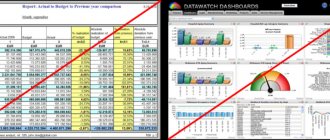What is a financial statement used for and who prepares it?
When the reporting period in any organization ends, all legal entities and individual entrepreneurs (IP) must submit annual financial statements. It is necessary for internal work, as well as for external specialists who will evaluate the activities of an enterprise or individual entrepreneur.
Organization or enterprise data
The preparatory part of drawing up this document consists of the following steps:
- the correctness of the recording of correspondence on accounting transactions for the previous year is checked;
- all erroneous entries that were identified during the inventory period are corrected;
- if the reporting needs to reflect transactions that were identified in the new year, then accountants make notes and carry out all events according to the documents;
- after checking all the data, taxes for the reporting period are calculated;
- the last step is to make accounting entries for the calculation of taxes and reform the balance sheet of the company or enterprise.
Chief accountant - responsible person
Annual reports are prepared by the chief accountant . The accountants who are subordinate to him must provide all the necessary figures for the reporting period for their area.
This document is the final document in the accounting process. This helps to trace the unity of all available indicators in primary papers and accounting registers.
Balance sheet
The balance sheet, being the main form, precedes the types and composition of the financial statements of any enterprise. It is a table in the first two sections of which all the company’s assets (property and working capital) are listed in value terms, and in the third, fourth and fifth – the sources of formation of these assets, i.e. funds, capital, reserves and loans. The construction of a balance sheet table is based on the equality of the amount of assets to the amount of financial costs. It indicates only the remaining indicators at the beginning of the reporting period and its end.
The dynamics of growth, changes or movements of a particular indicator during the entire analyzed period in the balance sheet can only be seen in general absolute figures that record the increase or decrease in value. The most detailed information is provided by the reports attached to the balance sheet.
Principles for drawing up the annual form
There are general requirements that apply to this document. These include the following:
- all information must be reliable, and each figure must be confirmed by another (monthly or quarterly) document;
- The sequence of filling out one or another form, which is a component of the annual accounting, must be followed. reporting;
- all figures must be verified and comparable with the figures reflected in the internal documents of the enterprise.
Also, the general requirements include the materiality and neutrality of the preparation of the annual report. The enterprise is obliged to attach to the papers with annual figures transcripts of individual items and, if necessary, additional indicators.
The following items should be disclosed in additional accompanying information:
- dynamics (in the form of a graph or table) of important financial indicators of the company or enterprise over the past few years;
- a certificate containing information about the planned development;
- planned financial investments;
- how the company uses borrowed funds and how risks are managed;
- the work of company specialists in the field of design work and during various experiments and scientific activities;
- environmentally friendly activities and so on.
Strict reporting forms: what applies to them
If errors were identified in the accounting entries for certain business transactions of the current period before the end of the year, then corrective entries should be made in the month when the shortcomings were identified. If distortions were identified after the end of the reporting year, then corrections should be made in December of the reporting year.
When errors were found after the annual report had already been completed and approved, then corrections were not made to the accounting records for the previous year.
Users of financial statements
The composition of the reporting is determined by the needs of its users. They are divided into two categories:
- Internal. These are company employees. They need information from reporting to plan the company’s activities and track results. The document is used by administrators, managers, and persons responsible for the development of the organization and its financial results.
- External. These may be investors, creditors, tax authorities, banking institutions, insurance companies. Reporting information is needed to make a decision on issuing a loan, starting cooperation, checking the legality of the company’s activities, and for information purposes.
A detailed presentation of data is a sign of a reliable company that is aimed at finding investors and creditors. Based on the information in the reporting, one can draw a conclusion about the success of the organization. With positive indicators, the company has more opportunities to receive investments, loans, and contracts.
Composition of annual financial statements: what is included in the document
The chief accountant can draw up the document himself or instruct his deputy to do this, but he will sign it with his own hand.
Interim report
First, interim reporting must be prepared, which consists of the following forms:
- "Balance sheet".
- “Profit and Loss Report.”
In addition, the company must provide other reporting forms, for example, a “cash flow report.”
Find out more about rural business.
Are you planning to open a business for the summer? Ideas on our website.How to write a business plan for a beauty salon?
Annual
To provide annual financial statements, the chief accountant must be able to prepare the following documents:
- enterprise balance sheet;
- a document containing data on income and expenses;
- capital statement;
- a document containing figures reflecting the movement of money;
- document attachment to the balance sheet;
- a note explaining the figures reflected in the report;
- public, budgetary and non-profit companies submit a report on the use of funds;
- the result of the audit report, which is issued based on the results of the audit of the accounting records. report.
The balance sheet is generalized figures in rubles for a certain date. This document is a table with columns and rows.
In one part of the form, which is on the right, funds are reflected by receipt, and in the left - by expense or composition of placement.
These are the passive and active parts, in which each type of funds is called a “balance sheet item.”
The amounts in the “Total” column of assets and liabilities must be equal, since these lines reflect the same funds.
Income and Expense Report
The income and expense report contains the following data:
- profit or loss from sales of goods or services, management expenses;
- income (+) and expenses (-) from operations;
- income tax, VAT, operating profit, non-operating income and expenses;
- net income (retained) minus extraordinary expenses.
Statement of changes in equity
The statement of changes in capital consists of the following documents:
- “Section on capital” - reflects the remaining amount at the beginning and end of the year, income and expenses.
- “Reserve future expenses” – the balance at the beginning and end of the year, and the movement of future expenses.
- “Data on estimated reserves” – the balance at the beginning and end of the reporting period, and estimated reserves.
- “Change in capital amounts” – information about the amount of capital, its increase or decrease.
- “Certificate” reflects data on assets at the beginning and end of the reporting period and information on budgetary and extra-budgetary funds for capital investments.
More information about reporting is described in this video:
The cash flow report consists of the following subsections:
- amount at the beginning of the period;
- incoming monetary units during the year;
- money was sent for expenses;
- residual amount at the end of the reporting year.
The “Intangible assets” section is presented in the form of two tables with detailed information on the amounts of accrued depreciation. Types of intangible assets include :
- intellectual property;
- organizational expenses;
- business reputation;
- other assets.
Find out what business you can start with minimal investment.
What business is relevant for women in Russia?Is it worth opening a franchise business?
The concept of financial statements
Reporting is a system that records the results of a company’s activities during the reporting period. It combines tables generated on the basis of statistical, operational and accounting indicators. This is the final stage of accounting. Reporting is needed for a number of purposes:
- Analysis of the efficiency of the enterprise by external structures.
- Analysis of economic indicators within the company.
- Operational work management.
- Based on the data obtained, further activities are planned.
All reporting information must be truthful. To check the reality of the information provided, the specified values are compared with data for previous periods. The document is formed according to the forms established by the Ministry of Finance of the Russian Federation.
Frequency of document creation
Reporting is divided into types based on the frequency of its formation:
- Annual. Carried out on the basis of paragraph 2 of Article 13 of the Federal Law of December 6, 2011 No. 402.
- Intermediate. Formed over a period of less than 12 months. The obligation to draw it up can be established both by law and by internal documents of the company. Detailed information about this reporting form is contained in paragraph 4 of Article 13 of the Federal Law of December 6, 2011 No. 402.
Almost all companies are required to prepare an annual form. Interim reporting is relevant only for a number of companies.
Compound
In 2020, companies are required to prepare interim and annual reports. The first combines:
- Balance. Compiled according to form No. 1.
- Profit and expense report. Formed according to form No. 2.
- Report on the movement of financial flows.
- A note with the necessary explanations.
The composition of the annual accounting statements was approved by the Federal Law of November 21, 1996 No. 129:
- Balance.
- Profit and loss report.
- Appendix to the report.
- Report on changes to the charter capital.
- Financial flow report.
- Report on the intended use of money.
- Audit conclusion (if required) that the information presented is accurate.
- Explanatory note.
IMPORTANT! An audit is considered mandatory for a number of organizations. However, some companies make a voluntary decision to audit. In this case, the results of the audit are also included in the reporting.
Details
Reporting forms and specifics for filling out the document are established by the Ministry of Finance of the Russian Federation. The explanatory note contains the following information:
- Evaluation of business transactions carried out by the company. It may include the extent of the sales market, exports carried out, and the company’s reputation in the market.
- Execution of the set plan, compliance with the established growth rates.
- Efficient use of available resources.
- Dynamics of key activity values over several years.
- Planned capital investments.
- Economic activities carried out.
This list is recommended. It makes sense in the note to indicate information that may be of interest to persons using the reporting.
FOR YOUR INFORMATION! Reporting is generated based on external users. For example, these could be counterparties, various commercial structures.
Laws governing annual accounts
Article 14 of Law 402-FZ talks about documents that should be included in the annual financial statements. When drawing up a document, you must be guided by the following legislative acts:
- PBU 4/99 “Accounting statements”.
- Regulations on accounting and accounting. reporting in the Russian Federation No. 34n.
- Order of the Ministry of Finance dated July 2, 2010 No. 66n “On accounting forms. reporting of enterprises".
Based on these legislative documents, every enterprise and company must fully disclose its costs and expenses in the form of annual financial statements.
How to prepare a high-quality annual report
New trends in the preparation and execution of annual reports. Recommendations for preparing individual sections of the annual report.
The company's annual report is one of the forms of reporting required by law to provide information to shareholders and any interested party.
Regulatory legal acts contain a very long list of information that must be disclosed by the company in the annual report submitted to the general meeting of shareholders. However, it is unlikely that only compliance with these legal requirements pushes companies to professionally prepare an annual report, which involves developing a logical structure, writing meaningful text, design and printing. Today, a high-quality annual report is not just a source of information for shareholders, but one of the tools for effective communications with potential investors and other interested parties. From this point of view, the company's annual report should fulfill the following tasks:
- attract investors' attention to the company and tell its investment idea;
- serve as a source of information about the company for investors;
- to form the investment attractiveness and business reputation of the company.
To successfully implement these tasks, the company must, firstly, know and understand the expectations and requirements of investors and, secondly, professionally organize the process of preparing the annual report.
Some trends of recent years
The information content of annual reports is not constant. Many external and internal factors can influence its content. Despite the apparent invariance of the structure and logic of constructing this document as a whole, something new appears in the reports from year to year: the emphasis in the presentation of information changes, the volume of some sections increases and the content of other sections decreases, new formats for presenting the report are developed.
In the last two years, the main external factor influencing the industry of annual reports has been the global financial crisis, as a result of which the demands of investors have changed and the requirements of regulators for the disclosure of information by issuers have increased. As a result, there have been some changes in the content of annual reports, and new trends in their creation and use have emerged.
Firstly, the role of the annual report has grown as a means of communication between the company and shareholders, potential investors and other interested parties. During the crisis, the importance of the trust of investors and other stakeholders for corporations has sharply increased, at the same time, widespread cost-cutting programs have limited companies in the choice of means of communication with investors. In these conditions, the inevitability of preparing an annual report due to the presence of relevant legal requirements has led to increased attention in corporations to the creation of this document in order to make maximum use of its capabilities to convey information about the state of the company and the results achieved to a wide audience of stakeholders and strengthen their confidence in companies.
Secondly, the globalization of financial markets has led to some leveling of the level of information disclosure in the annual reports of companies from different regions of the world. Competition in the global capital market is forcing corporations to disclose more information and do it better. For example, the annual report of Chemical Industries Colombo1 from Sri Lanka is performed at a comparable level with the reports of such corporations as Syngenta (Switzerland) and Monsanto (USA).
Thirdly, public discussion about the causes of the crisis has led to increased attention to such issues in corporate activities as the schemes and amounts of remuneration for top managers, the construction of a risk management system, and the analysis of financial results. As a result, the corresponding sections in annual reports began to change.
Interesting changes have also occurred in Russian practice of preparing annual reports in recent years. In particular, some positive dynamics can be observed in information disclosure (see Table 1
).
Despite all the obviousness and ease of use of the company’s official website to promote the annual report as the most convenient and least expensive way for shareholders and potential investors to obtain information, until recently not all companies used their Internet pages for this purpose. The situation began to improve only three years ago, and by 2009, almost all companies that prepare reports began to publish them on their websites (see Figure 1
). The next step, in our opinion, should be to simplify navigation on these sites so that searching for annual reports does not cause difficulties, and access to them is easy and simple.
A notable trend in 2010 was the interactivity of annual reports. The number of companies preparing interactive reports is growing rapidly, and some have abandoned the paper version of the report altogether. While there is no single standard for creating an interactive report, currently, in our opinion, the search for the optimal format for such a report is underway. There are electronic reports that have the same pages as the printed version, but they can be viewed directly on the website.
Of course, electronic documents, where all sections are interconnected, meet modern requirements for ease of handling information, and you can move from one to another, carry out a convenient search, and select from the mass of text only the information that interests the reader. However, most companies still continue to use the PDF document format, which is convenient in many respects, for the electronic version of their annual report.
During the crisis, the importance of a socially responsible approach to business has increased, and this is reflected in the reports. So far, a small number of Russian companies prepare social reports according to international standards (GRI and AA1000), but any corporation strives to highlight the fulfillment of social obligations in the annual report and assure readers of the sustainability of its development.
Work to improve the content of the annual report
Despite the above-mentioned positive statistical dynamics in information disclosure, the lag in the quality of Russian annual reports from foreign ones still remains quite noticeable. Confirmation of this fact can be found in the global ranking of ReportWatch annual reports, published on the website www.reportwatch.net: the annual report of only one company from Russia is among the 300 best reports from around the world, and it ranks only 271st.
Currently, in our opinion, the most problematic from the point of view of the quality of information disclosure are the following sections of Russian annual reports:
- Company development strategy.
- Management of risks.
- Management remuneration.
- Analysis of financial results.
For the sake of objectivity, we note that in Russia there are leading companies in reporting preparation, which from year to year become laureates and winners of competitions for the best annual reports, and the documents they prepare largely comply with international standards. For example, the reports of MMK and NLMK can serve as examples for other companies in terms of disclosing information about their strategy: in 2010, they significantly increased the amount of information disclosed in this section and made its presentation more visual.
There are also companies that make substantive sections on risk management, that is, they talk about how they manage risks, draw maps of the risks they face in their activities, provide a description of ongoing and planned risk management activities (MMK, Severo -West Telecom, etc.). Russian companies are gradually adopting the experience of Western companies in preparing the financial component of the annual report: they follow the Management Discussion and Analysis (MD&A) format, in which management evaluates and analyzes the company’s achieved financial results. True, there are still few such companies (Lukoil, Uralkali, etc.).
Annual reports of foreign companies will help us offer recommendations to Russian companies on improving the quality of their annual reports and eliminating gaps in information disclosure. We believe this is a very valuable and extensive resource for generating new ideas and creating a modern annual report that meets the needs and expectations of existing and potential investors. After all, these companies have accumulated significant experience in the field of forming relationships with investors in general and preparing annual reports in particular.
Strategy.
Information about the strategy is necessary for investors to assess the company's development prospects and make appropriate investment decisions, which is why this section is so important for the annual report and should not be neglected. Most often, Russian companies limit themselves to vague statements about the mission, strategic goal and priority areas of development, and in the worst case, there is no section on strategy in the report at all. Of course, the reason for this may be the lack of a strategy adopted by the company. However, we hope that such cases are rare, and all that remains is to learn how to competently formulate and describe the company’s development strategy. The following are typical shortcomings in the presentation of strategy in annual reports:
- insufficient attention to the analysis of possible scenarios for the development of the situation in the future and assessment of their impact on the implementation of the strategy and the activities of the company as a whole;
- lack of a report on the progress of implementation of the adopted strategy;
- lack of quantitative guidelines for the implementation of the strategy;
- failure to include in the description of the strategy a list of planned activities for its implementation;
- insufficient visibility of the information provided about the strategy.
Our first recommendation regarding the description of strategy in the annual report is to tell or at least mention the implementation of the strategy in the reporting period already in the management message that opens any report. The chairman of the board of directors, as the head of the management body responsible for monitoring the implementation of the strategy, must convey information about the strategy to investors in an accessible and understandable form, as well as convince them of the validity of choosing such a strategy. As an example, let's take a report from the American company Procter&Gamble. Here, the address of the chairman of the board of directors and the president of the company is entirely structured through a statement of strategy: all the results of the year are considered through the prism of the implementation of the strategy. This is very important, since Russian companies are often limited to only summing up the results of the reporting period, without comparing them with their strategic goals.
The second recommendation is to tell us about the progress in implementing the previously announced strategy in the reporting year. Among domestic companies, MMK’s report can be highlighted as a worthy example. An example of best foreign practice is the Air Liquide report, which provides a detailed analysis of the implementation of the strategy in 2009.
The third recommendation is to assess and describe the likely impact of market trends on the company's position in the future. An example is the PotashCorp report based on the results of 2009. The analytical part of this annual report begins with a discussion of macroeconomic and industry trends in recent years and continues with a rationale for the chosen strategy, based specifically on an analysis of the development prospects of the market in which the company operates. In addition, the PotashCorp report reflects not only historical data on the dynamics of changes in the market situation, but also the forecast values of these indicators.
The fourth recommendation is to describe the action plan for implementing the strategy. Listing only strategic goals and priority areas of activity, which Russian companies often limit themselves to in their reports, does not allow their readers to understand what specific actions are being taken by management to implement the chosen strategy. For an example of best practice, see a report from the Swedish company Electrolux. In its section on strategy, which, by the way, includes more than ten pages, there is a separate subsection Activities2, which details the company's actions to implement the strategy.
The fifth recommendation is to identify strategic guidelines, quantified goals of the company. They are necessary to monitor and evaluate the implementation of the strategy. The Procter&Gamble report states that the strategy is aimed at achieving such quantifiable indicators as sales growth, increased earnings per share, cash flow growth, etc., and also provides their specific target values. Similar financial goals are listed in the Electrolux report. With this data, investors can compare a company's performance to its goals and see how its strategy is progressing.
The sixth recommendation is to use graphics (charts, charts, pictures) to express your strategy in a simple, visual, and memorable way. Among Russian companies, it is worth noting the MMK report, which contains diagrams and diagrams that make the strategy easier to understand. Among foreign annual reports there are many excellent examples of a visual description of strategy: Electrolux, Adidas, Sasol, etc.
Management of risks.
The requirements of Russian legislation state that the company must include a description of key risks in its annual report. However, in our opinion, this is not enough to convince potential investors and other interested parties that the company is really ready for the possible realization of certain risks, and that it will be resilient under their influence. Therefore, in the annual report, in addition to describing the key risks, it is necessary to talk about how risk management is carried out, whether the company has a risk management system, what bodies, divisions and mechanisms it consists of, and how responsibility is distributed between them. Disclosure of information on these issues has become particularly relevant in the context of the recent global crisis.
Typical shortcomings of sections on risks in Russian annual reports include the following:
- the formality of the approach to disclosing information about risks, which is probably partly the result of a formal approach to building an internal control system in the company;
- lack of description of the risk management system;
- lack of quantitative assessment of risks: potential losses/benefits, on the one hand, and the likelihood of risks occurring, on the other.
Our first recommendation for a risk section in an annual report is to explain how the company manages risk. As an example, you can refer to the Vattenfall company report for 2009, which contains not only a classification of all the main risks, but also a detailed description of the principles and mechanisms underlying the system for managing these risks.
The second recommendation is to assess the likelihood of risks and the level of possible threats. A visual expression of these quantitative estimates can be the so-called cartarisk. As an example, pay attention to the annual report of the Finnish company Wartsila.
The third recommendation is to show the link between key risks and strategy execution, as Canada's PotashCorp does in its report. Here, for example, under the heading “Risks to our strategy,” possible market threats that could adversely affect the company’s results are described.
Management rewards.
As mentioned above, the recent crisis has led to increased attention from shareholders, potential investors, regulators and other stakeholders to the remuneration of senior management of corporations around the world.
This interest is obvious and is due to the desire of stakeholders to understand how reasonable the remunerations paid to managers are and how well they correspond to the results demonstrated by the companies under their management. If foreign corporations, especially British ones, even before the crisis demonstrated a fairly high level of disclosure of this information in their annual reports, then in Russian companies the situation on this issue continues to be quite deplorable (see table 2
).
Our main recommendations regarding the disclosure of information about the remuneration of senior management in the annual report are as follows:
- Provide a description of the principles on which the motivation system for members of the board of directors and senior executive management is built, as well as the criteria for determining the amount of remuneration paid to them. The most successful example in this area from foreign practice is the report of Royal Dutch Shell based on the results of 2009;
- show the relationship between remuneration and company performance, as, for example, was done in the BHP Billiton report for 2009, so that the validity of compensation payments to top managers does not raise any doubts among shareholders, potential investors and other stakeholders. BHP Billiton's annual report, in particular, shows how the company's fundamental indicators that are important to investors are changing and how this affects the level of remuneration paid;
- Disclose information about the amount of individual remuneration paid to each member of the company's senior management. Here, as an example, we should again pay attention to the Royal Dutch Shell report.
The financial analysis.
Financial statements are usually an integral part of any annual report, and often, with all the accompanying appendices, take up almost half of the entire report. However, financial information as part of the annual report will be of value, in our opinion, only if it is accompanied by a financial analysis of the results achieved. In foreign practice, for this purpose, the above-mentioned MD&A format has been developed and is widely used - financial analysis by management of the company’s performance. There are still few Russian corporations that use this format in their annual reports.
Basically, in the practice of disclosing financial information in the reports of our companies, a number of shortcomings still remain, the most typical of which include the following:
- publication of financial statements, but without a detailed explanation of the results achieved;
- Disclosed financial statements are not always accompanied by an auditor’s report, which may undermine confidence in their reliability;
- analysis of the company's performance is not related to the analysis of the external environment and the influence of various market and macroeconomic factors;
- insufficient visibility of the presented
- financial information due to the limited use of charts, graphs and tables.
Obviously, the main recommendations regarding financial analysis in the annual report boil down to eliminating the shortcomings listed above. When working to further improve financial disclosure, we recommend looking at the example of the German company Siemens' 2009 annual report as a good example of good practice on this issue.
It is also important not to forget about the validity of the disclosed results of activities, which involves a description of the factors and actions that led to the achievement of these results. This principle should be used not only when writing the financial review, but also when preparing all other sections of the annual report.
How to organize the process of preparing an annual report?
Creating a high-quality annual report that can serve as a reliable and effective communication tool with potential investors and other stakeholders is a complex and time-consuming process. Therefore, in conclusion, based on our own experience in implementing projects for the professional preparation of annual reports, we consider it necessary to recall the most important steps for effectively organizing the process of creating a high-quality annual report.
The company's success in preparing a high-quality annual report will largely depend on the timeliness of starting this process and meeting the deadlines for its completion. As a rule, it is more appropriate to start creating the report in the last quarter of the reporting year, rather than a month before the AGM, when the report should already be ready and distributed to shareholders.
The timely preparation and provision of information and materials for the annual report by all divisions of the company participating in this process should be facilitated by the appointment of a person responsible for the implementation of this project as a whole. It is preferable for this to be one of the company's senior managers. This will increase the significance of the project for preparing the annual report and the degree of responsibility and discipline in its implementation.
From the beginning of its work, the company should determine the purpose of preparing the annual report and the target audience to which it will be intended. The choice of these parameters will determine the format for preparing the annual report, its content, and the need to attract designers, consultants, and translators into a foreign language.
In accordance with the selected objectives and target audience, it is easier to determine the structure and content of the information that should be disclosed in this report, as well as to set a uniform standard for the provision of information about their activities by the company's divisions. The presence of such a standard, made, for example, in the form of a list of questions for departments, will, to a certain extent, improve the quality of the information they provide and bring them closer in style of presentation.
Results
- Annual financial statements are prepared by the chief accountant. This document is necessary for work within the company and for users who are involved in assessing the activities of the enterprise.
- The principles for drawing up the annual form are the correctness of the format and the reliability of all the numbers provided.
- The annual report includes a balance sheet of the enterprise, a document with reflected profits and losses, and others.
- The legal regulation of this document is carried out by certain documents.
Functions performed
The functionality of financial reporting extends in two directions: timely provision of reliable information and control over the situation in the company.
Information content presupposes in reporting the presence of information about the actual state of affairs and the results of the company’s activities, both in general and for all areas and productions.
The control function is to ensure high-quality monitoring of the provision of truly reliable information. Such internal financial supervision is carried out for each accounting cycle, i.e., each reporting period ends with the preparation of a financial report, which is the logical conclusion of the period and documentary evidence of the company's work results.
What is a public annual report and why is it needed?
The public annual report of an NPO is a report that visualizes the work done by the NPO in the past year. It clearly demonstrates how and on what the money of current donors was spent and serves as a presentation for potential ones. The format for presenting data depends only on the imagination of the compiler. But there are elements that should not be left undisclosed. Below I will talk about these elements and illustrate them with examples of disclosures from the winners of the competition for public annual reports of the non-profit organization “Starting Point”.








